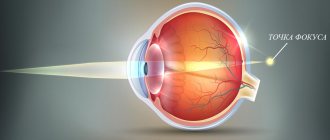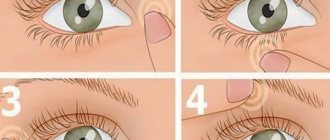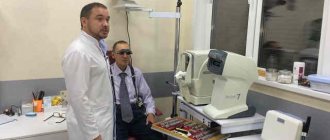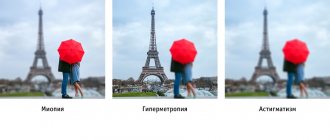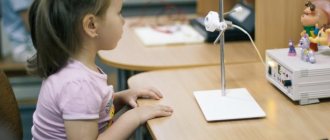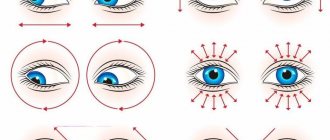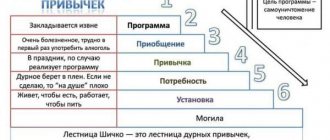Section 9. Treatment of myopia
9.1. Hardware (functional) treatment of myopia
Systematic influence on the accommodation apparatus in order to prevent the onset and progression of myopia allows one to normalize the tone of accommodation, increase the performance of the ciliary muscle, enhance the metabolic activity of the cells of the ciliary body, and improve the hemodynamics of the eye. Indications for functional treatment for myopia are: progressive myopia, relative amblyopia in congenital myopia, low values of ZOA and OAA, PINA, asthenopic complaints. Contraindications include: inflammatory diseases of the eye and its adnexa, young age of the child, poor tolerance of procedures, convulsive readiness.
Home workouts
Home accommodation training is prescribed 4 times a year and is often combined with other treatment methods.
- Exercise “Mark on glass” is carried out with glasses, daily, once, for 1 month. The first three days, the duration of each exercise is 3 minutes, the next three days - 5 minutes, on the remaining days - 7 minutes.
- The exercise with a “Racket” or a home accomodo trainer is carried out for 7-10 minutes. for each eye at 10-minute intervals. Against the background of exercises for 1 month. Patients are recommended forced instillation of Taufon solution 4%: 1 drop 4 times with an interval of 10 minutes. and instillation of irifrin solution 2.5%, 1 drop every other day at night.
- Home optical-reflex exercises using optical disaccommodation simulators (TDO - “Zenitsa”) are carried out for 5-10 minutes 4-5 times a week during the period of risk of developing myopia.
- Physical activity, mainly in the fresh air (swimming, badminton, tennis, gymnastics, dancing, slow middle-distance running, etc.) is recommended for uncomplicated myopia.
For myopia complicated by PVHRD, physical exercises associated with jumping and lifting weights, timed running, somersaults, and pull-ups are not recommended.
Yin and Yang or how to achieve harmony and health
Authors : Dombrovsky – Shalagin V.I.
Everyone who wants to have good health needs to breathe, and especially those who are on the brink of oblivion and for whom other treatment methods practically cannot help, they are offered a very specific option - a way to get rid of health problems associated with a lack of oxygen.
6.1. New quality of life without drugs and devices, article by A. Streltsov from the magazine “Modern Science - Pro and Contra” No. 2 (June) 2013
Russian State University of Physical Culture, Sports, Youth and Tourism
Vladislav Vladimirovich Vishnevsky celebrated his seventy-sixth birthday in a renewed state. Back in October 2012, he was constantly tormented by age-related ailments acquired over more than half a century: due to pain in the knee joint, he had to lift his right leg with his hand when he needed to get into the car. Sixty years ago they discovered sinusitis, during the period of exacerbation there was no escape from terrible headaches, I did punctures, nothing helped. Twenty years ago, bursitis appeared, when it is impossible for the arm to find a resting position. And constant acute pain in the muscles of the collar area when traveling in a car. What about heartburn from which there is no escape?
Six months later, everything changed. The pressure has long been 115/75, I got rid of the incessant cough, there are no problems with the joints, there is no longer any need to go to the doctor, the only medicine is aspirin. Age-related changes in our body occur when the oxygen supply of cells is disrupted, because of this the capillary network begins to collapse. It becomes clogged with waste products of the cells themselves, the blood flow slows down sharply, and in some areas stops altogether. In them, protein synthesis occurs differently than before, the activity of oxidative enzymes is weakened, and the function of cell membranes is disrupted. In the end, the cells themselves are destroyed and die due to a violation of homeostasis, that is, a violation of the internal environment of the body. An aging body at rest reduces the intensity of internal processes, heart contractions sharply increase during physical activity, and a discrepancy arises between the blood flow to the heart through the coronary vessels and a sudden increase in metabolic processes in the heart muscle, which often leads to insufficient blood supply.
Sclerotic changes develop in the endocrine, respiratory and nervous systems. Respiratory arrhythmia appears, the respiratory rate increases, pulmonary ventilation decreases, the functions of the digestive, excretory systems and osseous-ligamentous apparatus are disrupted, and skeletal muscles atrophy. The speed of motor reactions due to the weakening of the excitability of the nerve centers of muscle tissue is significantly reduced, as a result of which muscle mobility decreases.
Lack of oxygen in cells (hypoxia) also inevitably leads to functional and organic damage in various body systems, and, first of all, in the respiratory, nervous and cardiovascular systems.
That measured inhalation and exhalation to which we are all so accustomed is often no longer able to fully provide our body with the oxygen it needs. Heart failure is a condition in which the heart can no longer pump blood fully or be filled with a sufficient amount of it. He has to work with significant stress, as a result of which fluid retention occurs in the body, and our cells, organs and systems do not receive as many nutrients and oxygen as they require. But the cause of heart failure is simply problems accompanied by damage to the functions of the heart.
That is why over the past 15 years in Russia the number of cardiovascular diseases has increased 3 times and has acquired the character of a non-infectious epidemic. And the frequency of deaths from heart attacks, strokes, and vascular thrombosis has increased 2.5 times and is already 1.3 million people annually [1].
When we receive additional portions of oxygen, the metabolism in our body begins to recover, first of all, in the organs of the immune system: in the lymph nodes, in the spleen, in the bone marrow, in the thymus gland, etc.
Its tension in the alveolar air and in the blood plasma increases, shortness of breath decreases, the concentration of oxyhemoglobin in arterial blood increases, metabolic acidosis decreases due to a decrease in the amount of under-oxidized products in the tissues. There are no medicines that could compensate for this deficiency in nature, but by artificially introducing oxygen into our body, we can slow down the development of almost any disease, stop it and even begin to restore damaged tissues. The body itself begins to fight the disease, nutrition of the affected cells is resumed, and metabolism improves.
Back in 1931, Otto Warburg, a German chemist, received the Nobel Prize in Physiology or Medicine for what he predicted, which was then successfully confirmed: not a single pathogenic virus, bacterium or fungus can exist in the presence of oxygen, and vice versa, they appear only in places that are poorly supplied with it.
The only possible way to get rid of oxygen deficiency is oxygen therapy - providing the human body with oxygen found in respiratory mixtures in a concentration higher than in atmospheric air. To prepare such mixtures for the treatment of symptoms and manifestations of hypoxemia (a sharp decrease in the level of oxygen in the blood), concentrated oxygen is used. There are three main devices for storing it during long-term oxygen therapy: compressed gas cylinders, containers for storing liquefied oxygen, oxygen concentrators.
From a medical point of view, the use of concentrated oxygen for a sufficiently long time is a recognized standard of treatment (and in high performance sports it is also a stimulator of recovery processes after large and debilitating loads), very effective, absolutely safe, but economically very expensive.
Purpose of the work: to develop a publicly accessible, hardware-free method of oxygen therapy that would be effective for use in any place and under any conditions.
Organization of the study: In 2006, a number of experiments were conducted at the Russian State University of Physical Culture, Sports, Youth and Tourism (RGUPFKSMiT) on the effects of non-equipment oxygen therapy on the human body. Basis for the research: methodology developed in 1998-2003 in the Republic of Belarus [2].
program and methodology consisted of assessing the functional and emotional state before and after exposure to the human body of the so-called “fractional” breathing, or, in short, DD; Master's students of the Russian State University of Physical Education and Technology were used as subjects.
In the experiments, we used a computer hardware and software complex - an automated system for electrodermal express assessment of a person’s functional state “AMSAT-COVERT”, which determined deviations from the norm in the subjects’ endocrine, bronchopulmonary, cardiovascular, genitourinary and hematopoietic systems, gastrointestinal tract, organs of vision and ENT organs, spine, neurovascular bundles, large joints of the limbs.
The arithmetic mean, generalized, value of violations of all these systems and organs, without taking into account the sign, was taken as the particular criterion “effective value”, and the same, but taking into account the sign, as the integral criterion “balance”.
First, with the help of the AMSAT system, the subjects’ initial state was recorded, then the first trial session on motor training was conducted with them at rest, in a sitting position, which made it possible to imitate motor activity. The initial duration of this exercise was, depending on the individual characteristics of the body, only from one to three minutes.
DD is a breathing exercise that consists of four parts of one inhalation and a general accented exhalation; this allows you to simulate running activity in a static body position (sitting, standing or lying down) with varying degrees of intensity.
All subjects mastered the DD very easily and quickly; none of them ever had any difficulties in performing it. The repeated measurement was carried out on the same day, 50-70 minutes after the first lesson and for the duration that the subjects themselves were able to withstand; Despite the very short time that elapsed after the first lesson, a shift towards the physiological optimum of all assessed systems and organs was noted. Then, during this and the next two days, the subjects independently completed a total of 7 to 11 sessions, constantly increasing both the duration and frequency of DD, which is non-apparatus oxygen therapy.
Two days later, the subjects were measured for the third time, using the AMSAT system, to measure their functional and emotional state.
On average, the criterion “effective value” of all systems and organs between the first and second measurements approached the norm by 18.9%, between the first and third measurements – by 33.7%, the criterion “balance” between the first and second measurements approached normal by 20.6%, between the first and third – by 41.7%.
Table 1 shows indicators of emotional stress and criteria for effective meaning and balance among the subjects (initial state, after the first lesson and after two days of independent study according to a given program).
Table 1. Comparative assessment of the functional and emotional state of the subjects when they use natural breathing (NBR) and “fractional” breathing (FR).
Note: 1. The average time interval between the first and second measurements was 1 hour 23 minutes, between the second and third - 47 hours 20 minutes; 2. The degree of emotional stress in the subjects: N 4 - neurosis of the fourth degree, AOE 3 - asthenic negative emotion of the third degree, SPE 2 - asthenic positive emotion of the second degree, VMA 1 - attention, mobilization, activity of the first degree.
Based on the materials from the above experiments, a RF patent was issued in 2007 and received in 2009 [3].
The first check of DD was carried out back in 1997 in the specialized sanatorium “Rassvet” in the Minsk region on a group of patients with asthma and chronic bronchitis. First, on October 9, before the DD classes, their initial values were obtained, and just 12 days later, on October 22 of the same year, repeated measurements were obtained, after classes were conducted with them using breathing exercises specially developed for them. The measurements were carried out using a SPIROTUR-610 spirometer.
In table Table 2 shows comparative characteristics of two types of breathing in patients with bronchial asthma and chronic bronchitis before and after exercise. If initially almost all patients had very serious breathing problems, they were constantly suffocating and could not take a step without inhalers, then after 2-3 days they began to feel much more comfortable.
Comparative data of two types of breathing in patients before and after breathing exercises. Data taken from the description of the invention for patent No. 5010 of the Republic of Belarus, publication date March 30, 2003.
By performing DD in static conditions (sitting, standing or lying down) with a frequency of 40-60 respiratory cycles: four parts of inhalation - exhalation for at least five minutes continuously and at least three times a day, patients were able to radically change the situation. The internal respiratory tract was directly affected in such a way that they themselves began to work actively and provide the brain, heart, and other vital organs and systems with oxygen in full (without intensive leaching of carbon dioxide). Previously, a similar effect could only be achieved with running or other physical activity, but often the weakened body of patients was not able to produce movements of the required intensity. These changes only indicate that changes have begun to occur in their body towards the normalization of their activities, but if in the future DD is abandoned by patients, no further improvements will follow, since many patients have brought themselves to such a deplorable state for years and decades.
The task of DD, performed in a static body position, is to provide all our cells, organs and systems with air oxygen so that they can exist in comfortable conditions and carry out constant “repair” of damaged tissues and problem areas for themselves. Experiments also revealed that with four parts of a shallow breath of air, our body receives 2-2.5 times more oxygen than with a single deep breath, and its utilization is higher due to the fact that the time for the reaction between air oxygen and blood hemoglobin is significantly greater. more.
DD is excellent for the treatment of hypertension, as it is a vasodilator and normalizes blood pressure. Stressful situations and depressive tensions are relieved. DD is also a means of helping to prevent colds. In 2010, Maxim Perepechin, born in 1992, entered the Russian State University of Physical Education and Technology. Previously, he trained for a long time in the 200 and 400 m running, but could not even complete the first category, despite the fact that the coach gave him very heavy loads. At the university, training with him continued, but according to a system based on DD. For a very long time, it was not clear why Maxim’s athletic results were growing so slowly. Only a year and a half later, after he was declared fit for military service (he had a dream of entering the military academy in St. Petersburg and becoming a doctor), Maxim admitted that he had had heart problems since childhood. His medical history stated the following:
November 6, 2008 Mitral valve prolapse of the first degree (MVP stage 1) 5 mm, regurgitation (reflux of blood back into the right atrium) of the first degree, false chord of the left ventricle;
10/14/2009 MVP stage 1, mitral regurgitation of the first degree, false chord in the cavity of the left ventricle; From 08/31/2010 Perepechin began training to perform at distances of 200 and 400 meters according to the program that I presented in 2002 at the scientific competition of the European Athletics Association. He also used static damage control constantly. The result was the following:
September 20, 2011 MVP stage 1, without regurgitation, false chords in the cavity of the left ventricle;
02/28/2012 Stage 1 MVP, without regurgitation, additional chords in the cavity of the left ventricle, increased trabecularity of the apex of the heart (many muscle fibers of the left ventricle), while the chambers of the heart are of normal size, the myocardium is not thickened, homogeneous. What happened? And a very simple situation happened - in conditions when a very branched capillary network appeared in the body, our own stem cells in the damaged place were ready, as if by magic, to turn into the missing link. DD also contributes to the normalization of acid-base balance, the expansion of peripheral circulation, oxygen supply to cells, and increased blood microcirculation.
What about Vyacheslav Vishnevsky?
Deviations from the zero line above or below less than 20% are the physiological optimum. Over 20% are hyperfunctional deviations caused mainly by physical stress, below 20% are hypofunctional tensions caused primarily by weak blood flow, low oxygen supply to tissues or sluggish metabolic processes. At the first examination, Vishnevsky’s right kidney had a value of 66.7%, left – 26.9%, pancreas – 33.5%, stomach – 48.4%, esophagus – 48.6%, liver – 63.8% . From
Major problems were also noted in the prostate gland, right knee, cervical region, coccyx, and lumbosacral region. It was also necessary to pay attention to the neurovascular system of the right leg and thigh.
During the repeated examination, the following indicators were recorded: right kidney – 16.8%, left – 31.3%, pancreas – 21.2%, stomach – 17.9%, esophagus – 9.6%, liver – 12.5 %.
Problems were noted only in the coccyx, rectum - 41.4% and bladder - 8.1%. The effective value during the second examination approached the norm compared to the first examination by more than 40%, the balance improved 4 times.
Vishnevsky’s basal age, measured on January 17, 2013 on a fat mass analyzer, was equal to 37 (thirty-seven) years, that is, the percentage of moisture, percentage of fat, weight-height indicators, type of structure corresponded to 37 years, and this despite his passport age at that time was 75 years old.
conclusions
1. The use of DD in static conditions as a non-apparatus oxygen therapy allows you to train the respiratory muscles in various modes and with different durations, enrich your body with oxygen from the inhaled air, not only for athletes, but also for all those who themselves are no longer able to perform motor work of the required intensity .
2. DD is a mechanism for normalizing acid-base balance both in the case of excessive appearance of acids in the blood and in the case of an increase in the amount of bases in it.
3. Long-term use of DD helps to increase the efficiency of using oxygen from atmospheric air. Regular exercises stimulate peripheral blood circulation by expanding the capillary network, restore the function of the lungs and bronchi in acute and chronic diseases, and strengthen the immune system.
published 04/09/2014 10:45 updated 04/09/2014 — Treatment methods, Alternative medicine
- ← Previous
- Next →
Optical-reflex accommodation training
- Accommodation training according to E.S. Avetisov - K.A. Mats is carried out binocularly under conditions of full correction, once in the first 3 days, twice on the remaining days. At very low starting values of relative accommodation, exercises are carried out in a gentle manner: larger text is used for reading, exercise time is reduced, and negative lenses are changed in increments of 0.25 diopters. To clarify submaximal loads, the volume of relative accommodation is determined every 3 days. The optimal criterion for the effectiveness of such training is an increase in VA. The course consists of 15-20 workouts. To consolidate the effect, it is recommended to carry out the previously described home exercises.
- Optical microfogging method according to A.I. Dashevsky is performed for each eye separately. The duration of one workout is no more than 15 minutes for each eye. The course of treatment is 10 training sessions.
- Method of divergent disaccommodation according to A.I. Dashevsky. A necessary condition is stable binocular vision, a contraindication is exophoria for distances greater than 6.0 ∆ diopters.
- The “swing” method according to V.V. Volkov - L.N. Kolesnikova is used if it is not possible to achieve an increase in uncorrected visual acuity using the methods described above. Treatment is carried out monocularly under conditions of full distance correction.
- Ophthalmomyosimulator - relaxer "Visotronic". Mechanism of action: the relaxing effect of “glass atropine” or microfogging on the ciliary muscle due to positive spherical and cylindrical lenses, as well as the divergent disaccommodation effect caused by prisms.
- The medical device for training eye accommodation "Oxis" is intended for training accommodation, reducing PINA, preventing the progression of myopia at home and in an outpatient setting. The course of treatment includes 10 procedures, the duration of each procedure is 10 minutes.
- The device for training accommodation “Rucheek” can be used from 3-4 years of age.
To prevent the progression of myopia, optical-reflex training is prescribed 2 times a year. They alternate with home workouts and drug treatment.
Interregional public organization "Association of Ophthalmologists". Federal clinical guidelines: Diagnosis and treatment of myopia in children. Moscow, 2013. – 45 pages.
Federal clinical guidelines. Diagnosis and treatment of myopia in children
Exercises for training the ciliary muscle of the eye according to Volkov
Systematic influence on the accommodation apparatus in order to prevent the onset and progression of myopia allows one to normalize the tone of accommodation, increase the performance of the ciliary muscle, enhance the metabolic activity of the cells of the ciliary body, and improve the hemodynamics of the eye.
Indications for functional treatment for myopia are: progressive myopia, relative amblyopia in congenital myopia, low values of ZOA and OAA, PINA, asthenopic complaints.
Contraindications include: inflammatory diseases of the eye and its adnexa, young age of the child, poor tolerance of procedures, convulsive readiness.
Home workouts
Home accommodation training is prescribed 4 times a year and is often combined with other treatment methods.
1). Exercise “Mark on glass” is carried out with glasses, daily, once, for 1 month. The first three days, the duration of each exercise is 3 minutes, the next three days - 5 minutes, on the remaining days - 7 minutes.
2). The exercise with a “Racket” or a home accomodo trainer is carried out for 7 - 10 minutes. for each eye at 10-minute intervals. Against the background of exercises for 1 month. Patients are recommended forced instillations of r-ra taufon 4%: 1 drop 4 times with an interval of 10 minutes and instillations of r-ra irifrin 2.5%, 1 drop every other day at night.
3). Home optical-reflex exercises using optical disaccommodation simulators (TDO - “Zenitsa”) are carried out for 5-10 minutes 4-5 times a week during the period of risk of developing myopia.
4). Physical activity, mainly outdoor activity (swimming, badminton, tennis, gymnastics, dancing, slow middle-distance running, etc.) is recommended for uncomplicated myopia.
For myopia complicated by PVHRD, physical exercises involving jumping and lifting weights, running against the clock, somersaults, and pull-ups are not recommended.
Optical - reflex training of accommodation
1). Accommodation training according to E.S. Avetisov - K.A. Mats is carried out binocularly under conditions of full correction, once in the first 3 days, twice on the remaining days. At very low starting values of relative accommodation, exercises are carried out in a gentle mode: larger text is used for reading, exercises are shortened in time, and negative lenses are changed in increments of 0.25 diopters. To clarify submaximal loads, the volume of relative accommodation is determined every 3 days. The optimal criterion for the effectiveness of such training is an increase in VA. The course consists of 15 - 20 workouts. To consolidate the effect, it is recommended to carry out the previously described home exercises.
2). Optical microfogging method according to A.I. Dashevsky is performed for each eye separately. The duration of one workout is no more than 15 minutes for each eye. The course of treatment is 10 training sessions.
3). Method of divergent disaccommodation according to A.I. Dashevsky. A necessary condition is stable binocular vision, a contraindication is exophoria for distances greater than 6.0? diopter
4). The “swing” method according to V.V. Volkov - L.N. Kolesnikova is used if it is not possible to achieve an increase in uncorrected visual acuity using the methods described above. Treatment is carried out monocularly under conditions of full distance correction.
5). Ophthalmomyosimulator - relaxer "Visotronic". Mechanism of action: the relaxing effect of “glass atropine” or microfogging on the ciliary muscle due to positive spherical and cylindrical lenses, as well as the divergent disaccommodation effect caused by prisms.
6). The medical device for training eye accommodation "Oxis" is intended for training accommodation, reducing PINA, preventing the progression of myopia at home and in an outpatient setting. The course of treatment includes 10 procedures, the duration of each procedure is 10 minutes.
7). The apparatus for training accommodation “Rucheek” can be used from 3 to 4 years of age.
To prevent the progression of myopia, optical reflex training is prescribed 2 times a year. They alternate with home workouts and drug treatment.
Other types of hardware treatment
1). Low-intensity laser stimulation of the ciliary muscle using the MAKDEL 09 device is a transscleral non-contact effect on the ciliary muscle using infrared laser radiation. 10 procedures are carried out once or twice a day (in the latter case with a 30-40 minute break) 2-4 times a year.
2). Laser speckle, being a functional stimulator, makes the sensory apparatus of the eye work and also relieves tension in the accommodative apparatus. Treatment is carried out on an outpatient basis 2 times a year.

